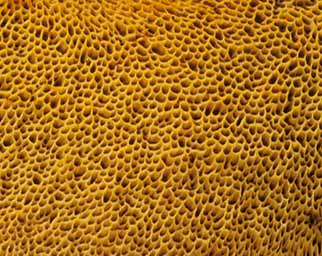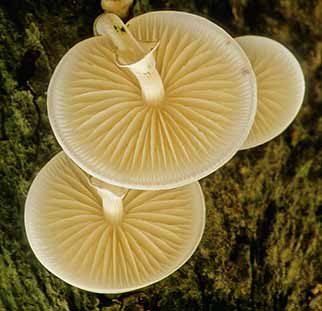Fungi identification - pores and gills
Spores can be defined as microscopic, dust-like reproductive bodies produced by fungi for distribution, often on the breeze, and eventual development of new fungi. Spore bearing surfaces may be tubes, gills, spines or other less common fungal features.
Now whilst this may not be very interesting to the relative lay person, it is important for those who wish to confidently identify fungi seen in the garden or whilst out walking, for methods of spore production often provide distinctive identification features.
Beware, though, that this is a somewhat superficial overview of what can be a quite extensive subject, provided only to help would be enthusiasts make sense of species accounts. Those wanting more detail should refer to the sources outlined in Fungi field guides and other reference material.
Pores

spaced and of variable size
These are small holes seen on the underside of the caps of some fungi - eg. the Southern Bracket Fungus and Cep - that are actually the open ends of tubes through which spores are discharged. (Size and spacing of the pores may be significant identification features).
Gills

of the Porcelain Fungus
Radially arranged structures which bear cells on which spores are produced, gills occur on the underside of the caps of some fungi - for example, the Amethyst Deceiver and Porcelain Fungus.
In some species they are well-spaced, relatively far apart, distant; whilst in others they are quite close together, or crowded. Whether of different lengths, forked or in seemingly random pattern may be important to correct species identification. Gill shape - for example, wavy, convex or arched - might also be significant, and so might the method of attachment to the stem.
Some other spore production strategies
A number of fungi, however, do not have tubes and pores nor do they have gills, but instead rely on different spore production strategies.
Puffballs and Earthballs, for example, hold their spores within the broadly circular structures that are such an integral part of their fruiting body shape. (The outer surface of the fruiting body eventually breaks down and the spores are released through breaks in the structure).
And teeth-like spines form spore bearing structures in the Hedgehog Fungus, and hanging spines in the Bearded Tooth fungus, whilst spores are produced within slim on the cap of the Stinkhorn.
Quick linksMore links
Other related links
Search this site

Sadly, 58 animals were killed - 35 ponies, 13 cows, 8 donkeys and 2 sheep, whilst a further 32 were injured - 3 pigs, 9 donkeys, 11 cows and 9 ponies.
(Forty-three accidents occurred in daylight, 15 at twilight and 101 in the dark. Twenty-seven accidents were not reported by the driver involved).
Here's just one horrific example - Three donkeys killed in collision with van at notorious New Forest blackspot (Advertiser and Times)

